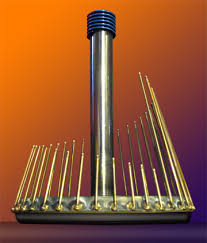Waterphone 
Invented And Developed By Richard Waters, A Waterphone May Be A Kind Of Un keyed Acoustic Instrument Consisting Of A Chrome Steel Resonator Bowl Or Pan With A Cylindrical Neck And Bronze Rods Of Various Lengths And Diameters round The Rim Of The Bowl. The Resonator Might Contain A tiny Low Quantity Of Water Giving The
Waterphone A vivacious Ethereal Sound That Has
Appeared In Pic Soundtracks, Record Albums, And Live Performances.
Several Sizes And Style Variants Of The Instrument Exist. It's Typically Vie In An Exceedingly Sitting Position By A musician And Either Bowed Or Drummed With Movements To Have An Effect On The Water Within. This Creates The Resonant
Characteristics Of The Bowl And Rods Together With The Movement Of The Water. The Sound Of The Waterphone Is Usually Wont To Evoke Mystery And Suspense. A
Super ball Mallet Has Become The Prime Method Of Taking Part In The Waterphone In An Exceedingly Friction Mode.
The Waterphone May Be A Trendy Invention Associated With The Tibetan Water Drum, A Round, Slightly Planar , Bronze, Drum With Associate Degree Aperture Within The Center High. In Step With The Creator Of The Waterphone, Richard A. Waters, The Waterphone Partly Relates To The Present Style Likewise Because The Nail Bowed Stringed Instrument, That Additionally Used A Resonator And Rods (Nails), And Is Affected Or Bowed.
The Waterphone Has Been Exhibited In Museums And Galleries
And Is That The Subject Of Many Short Documentaries In show And Television And Over Recent Decades The Waterphone Has Become Fashionable Symphonies, Itinerant Bands, And Recording Studios. Modern Classical Composers UN Agency Have Written Elements For Waterphone In Compositions Embrace Sofia Gubaidulina, Kraut Goldsmith, John Mackey, Tan Dun, Saint Christopher Rouse, Colin Matthews, Carson Cooman, Andi Spicer, Andrew Carter And Todd Barton. It's Conjointly Been Used conspicuously By Rock Musicians Richard Barone And Alex Wong (When Twiddling With Capital Of Austria Teng)And May Be Detected In Music By The Mouth Organ Pocket. Canadian Musician/Composer, Henry Martyn Robert pitched Battle, Has Been Composing For His Assortment Of Five Vintage Waterphones On Several Recordings Since The middle Nineteen Eighties. The Waterphone Is Employed To Nice Impact In Howard Goodall's "The
Dreaming", A Musical Commissioned By The National Youth Music Theatre Of Nice UK, Supported Shakespeare's "A Summer Solstice Night's Dream". Good all Uses Its Ethereal Sounds To Evoke The Mystery Of The Woods. Tom
Waits Could Be A waterphone Collector And
Player As Is Micky Bret Harte.
The Waterphone Has Been Featured Within The Soundtracks To Several Movies, As Well As Let The Correct One In (Film) (2008), The Matrix, Star Trek: The Flick, Music By Boche Goldsmith, Dark Water (2002 Film), And Crouched tiger, Hidden Dragon, ALIENS,
"The Spirit", Feminine Perversion "As Well As TV Production "24". Tan
Dun's Opera the Primary Emperor (2006) & "Water
Music" Feature The Waterphone. A Sound Sample Is Found At The Free sound Project. And Plenty Of A Lot Of. There's A Yearly "Waterphone Music Competition" Sponsored
By Richard Waters.
As The Waterphone Could Also Be Taken Into The Water, On Many Occasions The Waterphone Has Been Used With Success To Decision Whales And Alternative Cetaceans, Particularly By Jim Nollman Of Interspecies communication.





